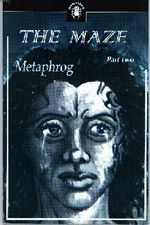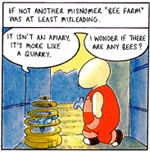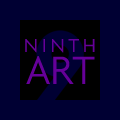>> Headspace: Inside The Mindscape Of Alan Moore
>> Four-Colour Crack: How to cope with a comics addiction
More...

They employ such a diversity of styles that they have been mistaken for an art collective. In fact, Metaphrog are Sandra Marrs (art) and John Chalmers (words) from Glasgow. Sandra is the artist, who brings the scenes to life with a keen eye for background detail. John, by training, is a scientist - that is to say, he has qualifications in physics. Perhaps that's why the stories have such crystalline structures.
The Metaphrog publication history has confounded the customary attempts by comic fans to pigeonhole the work into genres. In 1995 Metaphrog began to work on STRANGE WEATHER LATELY, described as "Five short comic stories from the surreal yet unnervingly real world of Martin Nitram".
Next came THE MAZE - the title suggesting it to be as convoluted as its predecessor. However, although the emotions and interactions of the cast of characters are complex, the story is fairly straightforward. Ostensibly a tale of a small community on a Greek island, THE MAZE uses mythology and mystery to confront contemporary sexual politics.
Eventually there was a new STRANGE WEATHER LATELY, running to ten issues, with several intertwining threads wrapped around the odd life of Martin Nitram. (What if Northern Exposure had been set in Glasgow ... and was more surreal?) Real life and fantasy crossover throughout what might be just a tale of the staging of a theatre play. Hallucinations and murder intersect with the coffee shop mundane. The characters get confused with the roles they are playing on stage. On first reading, that can also confuse the reader, but perseverance is rewarded as the threads unravel. Originally published over a year or so following on from the first issue, STRANGE WEATHER LATELY has been collected into two trade paperback volumes.
These titles came in conventional US comic format, but next came the mini-comic VERMIN. This is a short, sad tale about an infestation - or, more accurately, a visit - from mice. It's a good place to sample the Metaphrog story-telling style.
 The surreal and complex nature of STRANGE WEATHER LATELY and THE MAZE had observers worried when Metaphrog announced LOUIS - RED LETTER DAY, "designed to frighten and amuse children of all ages." It looks and feels like a children's book. LOUIS looks like a mole of some sort, and has a childlike perspective on the strange community he inhabits. However, there are more mature subtexts at play. Chalmers has referred to it as "Wallace and Gromit meets Kafka".
The surreal and complex nature of STRANGE WEATHER LATELY and THE MAZE had observers worried when Metaphrog announced LOUIS - RED LETTER DAY, "designed to frighten and amuse children of all ages." It looks and feels like a children's book. LOUIS looks like a mole of some sort, and has a childlike perspective on the strange community he inhabits. However, there are more mature subtexts at play. Chalmers has referred to it as "Wallace and Gromit meets Kafka".
In the midst of the Comics 2001 festival in Bristol, someone referred to John as, "Incredibly enthusiastic about comics, yet he doesn't know who is drawing the X-Men". However, John and Sandra have broad tastes. John's favourites include Charles Schulz (PEANUTS), Herge (TINTIN), Steve Ditko (THE QUESTION) and Carl Barks (SCROOGE MCDUCK). French-born Sandra is a fan of the works of Jean Louis Pesch, Enki Bilal, Hugo Pratt and Didier Comès - names on the fringes of Anglo-American comics, though in France they are considered mainstream.
John sums up his criteria for books he enjoys as, "Genuinely funny comics not written for financial gain; character-based stories and decent storytelling rather than trademarks.
"Children recognise the anarchism and satirical content of comics. A finger up to authority or hypocrisy. A person's inner world is partially formed by early experiences and comics were certainly a part of that. Learning about the comics industry has been very gradual, for us it's a DIY thing, akin to punk or fanzine culture; something empowering, providing a sense of purpose and, of course, carrying an inherent responsibility. Realising you know nothing really, but trying, and hopefully learning a little and being able to advise others where possible.
"The comics I enjoy are honest ones, things that have passion, not necessarily technically polished works. There's a lot of excellent stuff around and the best of it, for me at least, comes from creators with an innate need to write, or draw."
A common stylistic thread in Metaphrog's books seems to be experimentation with story, narrative and art styles. Sandra's knowledge of arts and literature gives her a range of influences. She is interested in the arts of the turn of the Nineteenth century, and the appearance of new arts and the shift in ideas at that time. Likewise the Renaissance period, and the arts and designs of extinct civilisations. "In literature, Zola has made an impression on me, and later Lévi-Strauss, the existentialists, the romantics. Cinema is also a big influence, mostly films made before the end of the seventies. Film noir and French pre- and post-gangster movies, the early horror, Leone's work, Buñuel...
 "But then again, the list would be too long. Although some particular arts and artists may have influenced me more than others, one gets influenced by everything in life. The creative process is not really something one can reduce to a formula or trace back to its roots. Experimenting is integral to artistic activity, and also life in general, as it allows us to learn. In our work, story, narrative and art styles, the technical aspects, which we enjoy playing with and figuring out, are different for each piece of work, but the main underlying themes are consistent, the former being used to serve the latter".
"But then again, the list would be too long. Although some particular arts and artists may have influenced me more than others, one gets influenced by everything in life. The creative process is not really something one can reduce to a formula or trace back to its roots. Experimenting is integral to artistic activity, and also life in general, as it allows us to learn. In our work, story, narrative and art styles, the technical aspects, which we enjoy playing with and figuring out, are different for each piece of work, but the main underlying themes are consistent, the former being used to serve the latter".
John adds, "Everything is influential in a way, and any art exploring the parameters of a medium is exciting. All art has a profound effect on us. It's unfortunately virtually impossible to list something like that systematically, without attaching an inappropriate weight or significance. Dada and its energy was a big influence, you can trace a lineage through situationists and punk, it still resonates today. In literature, The Beat poets, Lewis Carroll, Burroughs, Bukowski, Camus, Sartre, Boris Vian, and Joyce, Beckett, Kafka, Kundera, Tutuola, Knut Hamsun, Paul Auster. The films of Polanski, Sergio Leone.
"The anthropologists and any humanitarian writers that try to get at some grain of truth. The literary books of Henry Miller were favourites, somehow he made you feel it was possible to be a writer, he read like a friend talking. No particular singular influence though, and I still find myself reading a lot of fiction but also biographies and technical thesis, linguistics, philosophy, Chomsky, economics".
In STRANGE WEATHER LATELY, we are shown two sides to many of the events in the story. That might make it difficult for a reader to find a sympathetic character, but John feels this challenge to the reader is justified. "STRANGE WEATHER LATELY is getting at the highly fragmented nature of our contemporary existence. In a way, Martin Nitram is a conventional protagonist, a conduit for events, an everyperson. So, yes, the reader would be justified in expecting to be able to find an entry point, a means to sympathise or literally share an opinion or feeling, with such a figure.
"Perhaps because the shared experience is unpleasant and uncertain the book is less accessible? It's a question of taste, where some have really enjoyed the book others have found it repellent. But there are clues and signifiers, like the palindromic protagonist. The characters are obfuscated: hence the reader-author is as the story unfolds. We hope to improve on what we're doing and realise that by experimenting, making mistakes, trying, we'll hopefully produce something of worth."
 John and Sandra started on STRANGE WEATHER LATELY very soon after they first met. Sandra says the story came from a mix of initial individual ideas and the collaboration process, but adds that they've always bounced ideas off each other and shared similar experiences.
John and Sandra started on STRANGE WEATHER LATELY very soon after they first met. Sandra says the story came from a mix of initial individual ideas and the collaboration process, but adds that they've always bounced ideas off each other and shared similar experiences.
John identifies the governing theme of SWL as loss, but they wanted to fold a lot more into the mix. "Social issues that are important to us, as well as environmental matters, aspects of globalisation and media manipulation, were all initial ideas. He says they made bimonthly comics partly due to financial limitations, but also because the format suited the fragmentary nature of SWL and facilitated experimentation with the medium itself.
"The parts where we collaborate most are on page layout," explains John. "The script takes the form of rough panel breakdowns, but there has to be a degree of flexibility to allow the timing to be adjusted. The story itself is so complex and multi-layered that it required careful planning in advance, and then could be firmed up into script form in time for the layout and art to get done. But we work closely as a team and can get more or less instant responses from each other."
Despite their different cultural and geographical backgrounds, John says the have much in common. "Sandra was already painting, doing photography, and I wanted to try to write. I'd not given it any real thought, but felt that if I didn't write I wasn't going to be very healthy. Our meeting was the catalyst - we wanted to work on something right away. Being creative can be liberating but there's a lot of craft and hard work involved. Having developed some skills individually, mutually we felt capable of learning about producing publications, going about creating stories, and the first comics followed from there."
Asked if there will be a SWL follow up, John says "It's hard to tell with these things, we've a lot of ideas we'd like to explore. Sometimes it would be good to fix time and slow things down."
Adrian Brown's interview with Metaphrog continues next week in Ninth Art, when John and Sandra talk about the LOUIS books, the Glasgow scene, and the small press struggles of promotion and distribution. For more on Metaphrog, check out Adrian Brown's Q&A with the team in issue one of Borderline magazine.

This article is Ideological Freeware. The author grants permission for its reproduction and redistribution by private individuals on condition that the author and source of the article are clearly shown, no charge is made, and the whole article is reproduced intact, including this notice.


